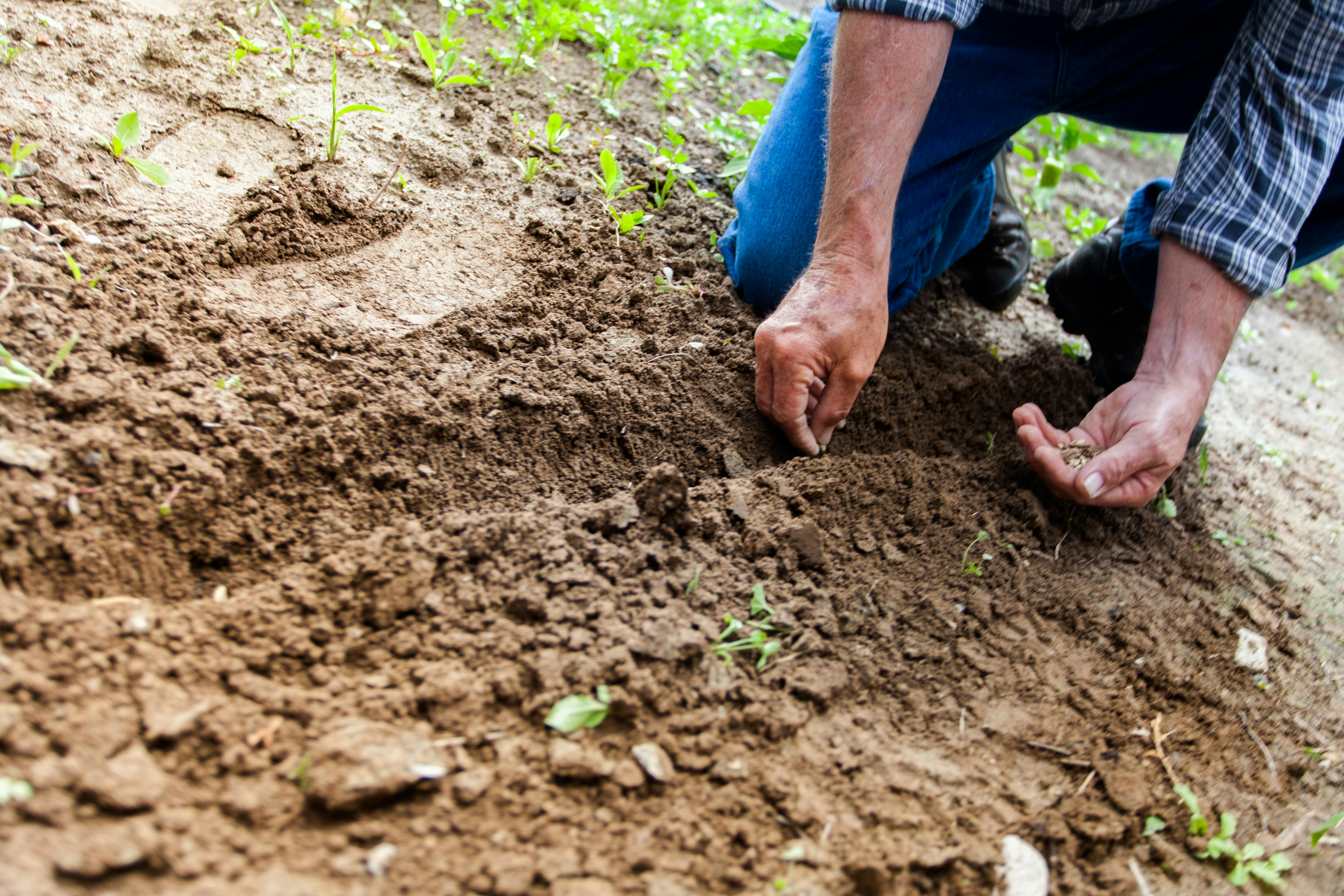Storing seed potatoes correctly is essential to ensure they remain healthy and viable until you’re ready to plant them. Seed potatoes are typically available in garden centers and nurseries during the winter, so it’s important to store them until they’re ready to be planted in the spring. With the right storage conditions, you can keep your seed potatoes fresh and undamaged until it’s time to get them in the ground. Here are some tips on how to store seed potatoes until planting.To prepare potatoes for planting, begin by selecting healthy seed potatoes. Cut each potato into pieces that contain at least two eyes. Allow the cut pieces to dry overnight in a cool, dry place. Once dry, dust each piece with a fungicide to prevent disease. Plant the pieces 4-6 inches deep and 12-18 inches apart in well-drained soil and full sun. Water thoroughly after planting and keep the soil moist throughout the growing season.
Choosing the Right Potatoes for Storing
When choosing potatoes for storing, it is important to select those that are firm and have smooth skins. Avoid any potatoes that are soft, wrinkled or have blemishes on them as these potatoes will not store well and will rot quickly. Potatoes with green spots should also be avoided, as this indicates that the potato has been exposed to too much light and thus has a bitter taste.
It is also important to choose potatoes of the same size when possible, as they will take the same amount of time to cook. When stored in a cool, dark place with plenty of ventilation, your potatoes should last up to six months. However, if you store them in an area that is too warm or humid, they will spoil much sooner.
The best types of potatoes for storing are those that are high in starch content and low in moisture content. Examples include russet and Yukon Gold varieties. Other types such as red potatoes can also be stored but tend to not last as long due to their higher moisture content.
To ensure that your potatoes stay fresh for a longer period of time, it is important to keep them away from other fruits and vegetables which give off ethylene gas which can cause them to spoil faster. Additionally, make sure they are stored in an area with good air circulation so that they do not become moldy or mildewed. Finally, it is important to check on your stored potatoes regularly and discard any that show signs of spoilage before they contaminate the other ones.
With proper storage techniques, you can enjoy your potatoes for months after purchase!
Storing Seed Potatoes in a Cool, Dark Place
Storing potatoes correctly is important for maintaining their quality and keeping them in good condition for planting. Seed potatoes should be stored in a cool, dark place that is well-ventilated. The ideal temperature for potato storage should be between 40-50°F (4-10°C). It is important to keep the potatoes away from direct sunlight and heat sources, as this can cause them to sprout prematurely.
It is also important to make sure that the storage area is consistently dry and has good air circulation. Excess moisture or humidity can cause mold and rot to form on the potatoes, making them unsuitable for planting. If stored properly in a cool, dark place, seed potatoes can stay viable for up to six months.
When selecting potatoes for storage, make sure they are free of any bruises or cuts. Damaged potatoes should be avoided as these areas provide a perfect environment for mold and rot to form. Additionally, avoid storing potatoes near apples, pears or onions as these produce ethylene gas which can cause the potato skins to turn green or even sprout prematurely.
When it comes time to plant your seed potatoes, make sure they have had enough time to adjust to the warmer temperatures before planting them outside. This will help ensure that your plants will get off to a good start and produce plenty of delicious tubers at harvest time!
Packaging and Labeling Seed Potatoes
Packaging and labeling seed potatoes is an important part of ensuring that they reach the consumer in the best condition. Proper packaging and labeling will protect the seed potatoes from damage or spoilage during shipping and storage, while labeling will help to identify the specific type of seed potato. Proper packaging and labeling of seed potatoes also helps to ensure that consumers have all the necessary information to make informed decisions when purchasing these products.
When packaging seed potatoes, it is important to ensure that they are properly sealed to prevent any moisture or air from entering the package which could lead to deterioration or spoilage. Appropriate cushioning material should also be used to protect them from any rough handling during shipping. It is also important to label the packages with information about the variety, weight, pack date, seller’s name, and other relevant information. This will enable customers to make informed choices when selecting seed potatoes for their gardens or fields.
The labels on seed potato packages should also include instructions for planting and care. This will help consumers get the best results from their seed potatoes by providing them with essential information on how to plant and take care of them correctly. It is also important for customers to be able to easily identify different varieties of potatoes by their labels so that they can choose those which are right for their needs.
In conclusion, proper packaging and labeling of seed potatoes is essential for ensuring that they reach consumers in good condition as well as providing them with all necessary information about variety, weight, pack date, instructions for planting and care etc., so that they can make informed decisions when purchasing these products.
Checking on Stored Seed Potatoes Regularly
Storing seed potatoes correctly is essential for growing a successful crop. It is important to check on the stored seed potatoes regularly to ensure they remain in good condition. Make sure the storage area is cool, dark, and well-ventilated. If the potatoes are stored in a plastic bag, be sure to check the bag for holes or tears that could lead to air circulation problems. Inspect the potatoes for any signs of disease such as discoloration or mold. If any of these signs are present, discard the potatoes immediately and do not use them for planting. If the potatoes remain in good condition, keep them in storage until it is time to plant them in the garden.

Preventing Moisture Build-Up when Storing Potatoes
Potatoes are a staple in many diets, and when stored properly can last for months. Unfortunately, if potatoes are not stored properly, they can quickly spoil due to moisture build-up. To prevent this from happening, there are several steps that can be taken to ensure the potatoes remain fresh for as long as possible.
The first step is to select the right type of potato for storage. The best potatoes for long-term storage are russet or Yukon Gold potatoes. These varieties have a thicker skin which helps to keep the moisture in and protect them from spoiling.
When storing potatoes, it is important to make sure that they are kept in a cool, dark environment with plenty of air circulation. Potatoes should never be stored near ripening fruits or vegetables, as these items give off ethylene gas which can cause the potatoes to spoil faster.
It is also important to avoid storing them in plastic bags or containers as these materials do not allow adequate air circulation and may cause the potatoes to spoil faster. Instead, store them in a breathable container such as a burlap sack or paper bag with holes punched into it so that air can circulate freely around the potatoes.
Finally, it is important to check on your potato supply regularly and discard any potatoes that show signs of softening or sprouting. This will help prevent any further moisture build-up and will help keep your potato supply fresh and flavorful!
Maintaining Temperature for Optimal Potato Storage
Storing potatoes properly is key to preserving their flavor and texture. To get the most out of your potatoes, it is essential to maintain an ideal temperature for storage. Potatoes should be kept at a temperature between 45-50°F (7- 10°C) in a dark, well-ventilated area. It is important to keep the storage environment as dry as possible, as moisture can cause potatoes to spoil quickly.
If you are storing potatoes over a long period of time, it is best to store them in a root cellar or other cool, dark place that maintains a consistent temperature range of 45-50°F (7- 10°C). This type of storage will help keep potatoes from drying out and becoming discolored. Additionally, it will help prevent the growth of bacteria and mold that can cause spoilage.
If you are unable to store your potatoes in a root cellar or other cool place, make sure they are stored in an airtight container away from direct sunlight and away from any sources of heat, such as stoves or radiators. Additionally, make sure the potatoes are stored away from onions and other vegetables that produce ethylene gas, as this can cause potatoes to spoil more quickly.
It is also important to check on your potatoes regularly and remove any that have started to sprout or show signs of spoilage. Potatoes should be used as soon as possible after purchase for optimal flavor and texture. Following these tips will help ensure that your potatoes remain fresh and delicious for longer periods of time.
Controlling the Environment When Storing Seed Potatoes
When storing seed potatoes, it is important to maintain the proper environmental conditions to ensure that the seed potatoes are stored in good condition. To do this, the temperature and humidity of the storage environment should be carefully monitored and controlled. The optimal temperature range for storing seed potatoes is between 45 and 55 degrees Fahrenheit, while the ideal humidity levels should stay between 70 and 80 percent. Too high of a temperature or too low of a humidity level can cause the potatoes to dry out or even rot.
To maintain an ideal storage environment for seed potatoes, it is important to use a cool, dark room with good ventilation. It is also important to regularly inspect the potatoes for signs of mold or other damage, and to discard any affected tubers. Additionally, any damaged tubers should be removed from the storage area as soon as possible in order to avoid contamination of healthy tubers. Finally, it is important that all potatoes remain covered with a light layer of soil during storage in order to prevent them from drying out and becoming unusable.

Conclusion
Storing seed potatoes is an important step in ensuring a successful harvest. When stored properly, potatoes can remain viable for up to 7 months before planting. The best way to store seed potatoes is in a cool, dark and well-ventilated area. Keep the potatoes in single layers and in paper bags or cardboard boxes. Avoid storing them near apples or other fruits because they can cause potatoes to rot faster. When you are ready to plant, check your seed potatoes to make sure they are still viable and discard any that are soft or shriveled. With a little bit of care and attention, you can ensure that your seed potatoes remain viable until planting time and result in a bountiful harvest!

